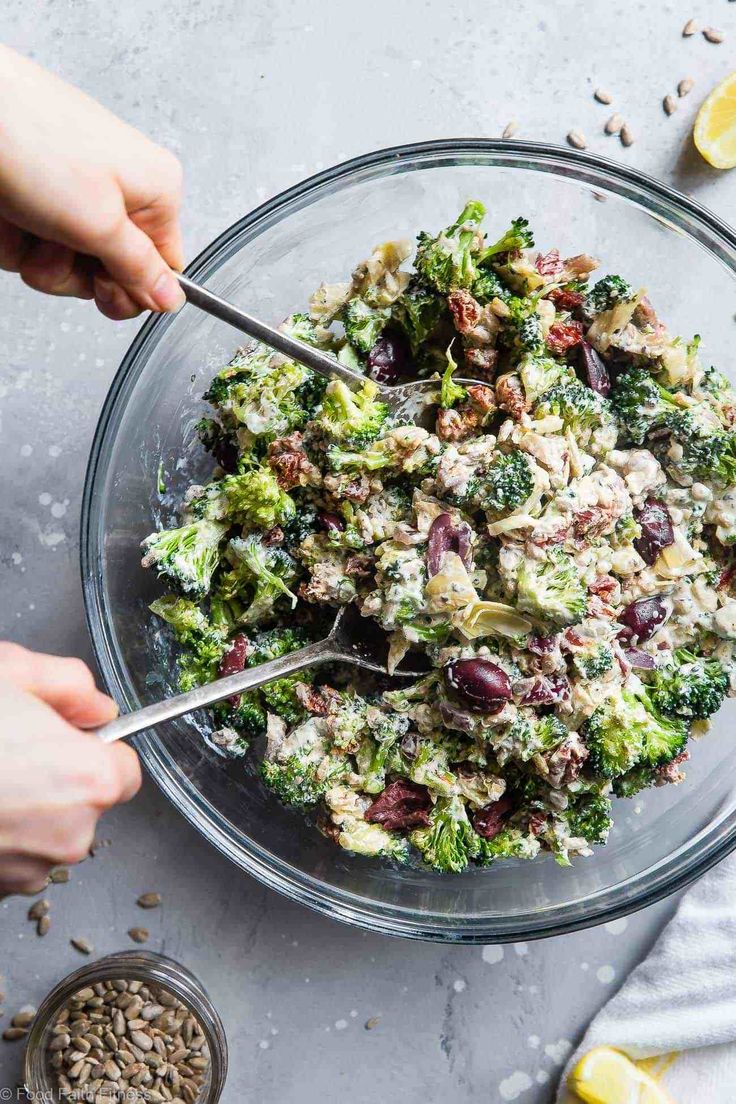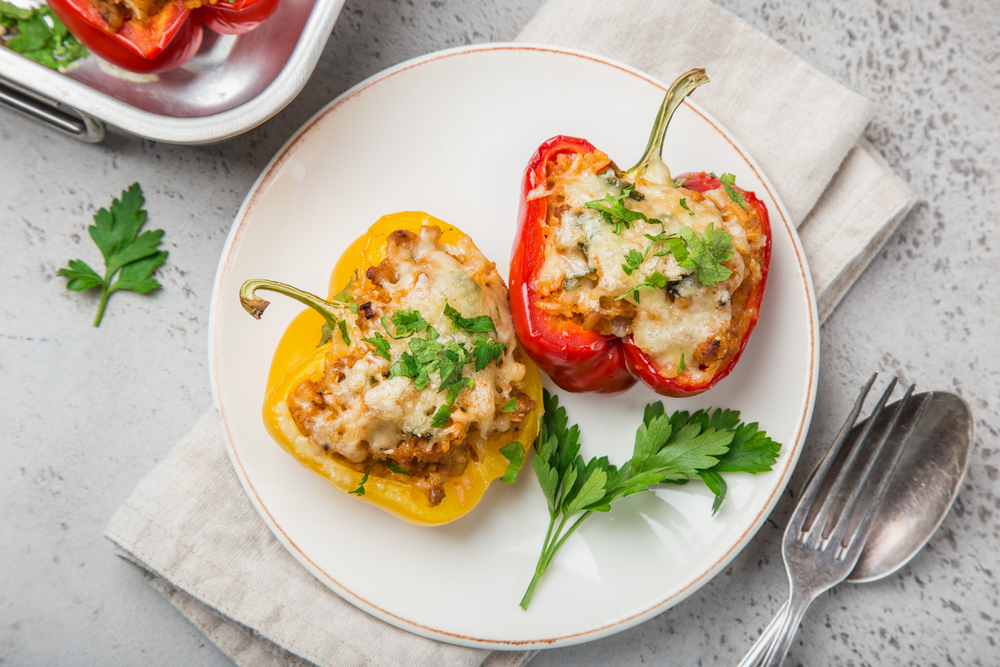Dinnertime is different when you have type 2 diabetes. Specifically, strategies like carbohydrate counting and portion control are essential in order to manage weight and improve your A1C — your average blood sugar level over the past three months. Also, nutrition is vital as everyone can benefit from it.
“My advice for people with type 2 diabetes would be to seek a balance of nutrients in their diet”, says Amy Kimberlain, registered dietitian and certified diabetes care.
She also recommends making lean protein a quarter of your place, carbs another quarter, and nonstarchy vegetables the other half. “Eating a balanced diet not only helps your blood sugar levels remain within a healthy range, but are also incredibly filling”, Kimberalian notes.
That doesn’t mean you have to compromise taste. These 5 diabetes-friendly recipes are tasty and balanced enough for anyone to enjoy, regardless of whether they have diabetes.

Mediterranean Low-Carb Broccoli Salad
Servings: 8, as a side
Cook Time: 25 min
This salad recipe is packed with nonstarchy vegetables, including artichoke hearts, broccoli, onion, and sun-dried tomatoes. These foods contain high amounts of fiber, which will help you stay full longer.
Both olives and olive oil provide healthy fats, making this recipe a heart-healthy option as well. According to the Centers for Disease Control and Prevention, diabetes doubles the chance of developing heart disease. Therefore, it’s critical to include monounsaturated fats in your diabetes diet.
Ingredients
FOR THE SALAD:
- 5 cups broccoli (380 g), chopped into small florets
- 1/2 cup (75g) sun-dried tomatoes in olive oil, roughly chopped (oil squeezed out)
- 1/3 cup diced red onion
- 1/2 cup pitted Kalamata olives, halved
- 1/4 cup roasted sunflower seeds (salted)
FOR THE DRESSING:
- 2 cups plain Greek yogurt (non-fat)
- juice and zest of 1 large lemon
- 1 3/4 tsp dried oregano
- 1 1/2 tsp dried ground basil
- 4 1/2 tsp Monkfruit, (or another type of granulated sweetener)
- 1 1/2 tsp fresh garlic, minced
- 1 1/2 tsp dried ground thyme
- 2 Tbsp olive oil (you can use the one from the jar of sun-dried tomatoes)
- 1 tsp sea salt
- pepper
Directions
- In a large bowl, combine all of the salad ingredients
- In a medium bowl, mix together all of the dressing ingredients
- Pour the dressing over the salad and stir well. Cover and refrigerate for about two hours (you can even leave it overnight), to allow the broccoli to absorb the dressing. This is an important step as it will boost the flavor.
- DEVOUR!
Healthy General Tso’s Chicken
Servings: 4
Cook Time: 30 minutes
General Tso’s Chicken is a famous Chinese Food takeout dish that is slightly spicy, but sweet and very easy to make at home! This is a diabetes-friendly version of the original recipe, so it’s made without breading. It has fewer calories but tastes just as good as the fried original.
Those who have diabetes may want to avoid fried foods, which are high in fat and simple carbs. Since fat takes longer to digest, it won’t only raise your blood sugar level but will also keep it high for a really long time.
Now, this recipe goes perfectly with rice, but you can use any other side dish you prefer.
Ingredients
FOR THE MARINADE:
- 2 boneless chicken breasts, cut into thin parts
- 2 tsp cornstarch
- ¼ tsp sea salt
- 1/8 tsp ground pepper
FOR THE SAUCE:
- ¼ cup no added sugar tomato ketchup
- 4 tsp hoisin sauce
- 4 tsp soy sauce
- 2 Tbsp rice vinegar
- 4 tsp brown sugar
FOR THE STIR-FRY:
- 2 Tbsp peanut oil
- 1 scallion, chopped
- 1 tsp sesame seeds (toasted)
- 1 dried red chile (optional)
Instructions
- In a medium bowl, mix the cornstarch, pepper, and salt. Add the chicken and make sure it’s well-coated. Let marinate at room temperature for at least 20 minutes.
- In a separate bowl, make the sauce by mixing together the ketchup, hoisin sauce, soy sauce, rice vinegar, and brown sugar. Set the sauce aside.
- In a wok, heat up your peanut oil over medium-high heat. Add in the chicken and stir-fry until fully cooked or slightly brown.
- Pour in the sauce and add the chile. Stir well to coat the chicken.
- Remove the wok from heat and transfer the chicken to a serving plate. Garnish with chopped scallion and sesame seeds. Enjoy!

Mediterranean Grilled Salmon Kabobs
Servings: 4
Cook Time: 40 min
Salmon is a wonderful choice of fish for those with type 2 diabetes because it’s packed with omega-3s, the “healthy” fats that can help you reduce the risk of common diabetes-related conditions like stroke, heart failure, and heart disease.
The salmon skewers are grilled, resulting in flaky, charred salmon and juicy and tender veggies. This delicious meal goes great with tzatziki sauce for a truly Mediterranean feel. No grill? Don’t worry, this recipe can be cooked indoors on the stovetop or in the oven.
Ingredients
- 2-pound salmon fillet
- 1/3 cup olive oil
- 4 cloves garlic, minced
- 1/4 tsp coriander
- 1/2 tsp chili powder
- 1 tsp thyme
- 1/4 tsp coriander
- 1/2 tsp cumin
- 1 tsp dill
- 1 tsp oregano
- 1/4 tsp red pepper flakes
- 1 tsp sea salt
- 1/2 tsp ground black pepper
- 1 small red onion
- 1 large zucchini
- 2 lemons
- 2/3 cup grape tomatoes
Directions
- Remove the skin off the salmon fillet and cut it into 1-2 inch chunks. Thinly slice the red onion and zucchini with a mandoline or a sharp knife.
- In a large bowl, toss the cubed salmon, veggies, olive oil, and dried spices. Squeeze the lemons and add the juice. Toss to combine. Cover the bowl with foil and refrigerate for at least 20 minutes to marinate.
- Once the salmon and vegetables have marinated, spray with cooking oil 6-12 inch metal skewers and add all the solid ingredients. Whilst alternating salmon and veggies isn’t required, it will make the kabobs look pretty.
- Heat your grill to 350°F after spraying it with cooking spray. Once the grill is hot, place the kabobs on it and cook for 3-5 minutes per side. You’ll know that salmon is cooked when it turns pink. Remove from the grill and serve immediately with tzatziki sauce. Enjoy!
Keep reading to find out other diabetes-friendly recipes!
Low-Carb Zucchini Lasagna
Servings: 4
Cook Time: 1h 30 min
This low-carb zucchini lasagna is a delicious diabetes-friendly alternative to traditional lasagna. It boasts 30 grams of protein, only 8 grams of fat, and 12 grams of carbs per serving!
And yes, you’ll need ground beef for this recipe. While red meat is known to increase the risk of cardiovascular disease and raise cholesterol, eating it occasionally won’t do any harm. Better yet, lean ground beef is the best option for those with diabetes, who should avoid trans and saturated fats.
Ingredients
- 16 oz lean ground beef
- 4 1/2 oz onion
- 2 medium zucchini
- 1 serrano chili
- 3 tomatoes
- 2 cloves garlic, chopped
- 5 1/2 oz mushrooms
- 1/2 cup shredded low-fat mozzarella
- 1/2 cube Knorr chicken bouillon
- 1 tsp dried thyme
- 1 tsp paprika
- 1 tsp dried basil
- salt & pepper
- cooking spray
Directions
- Cut the zucchini into 1/2-inch slices using a julienne peeler. Sprinkle a little bit of salt and set aside for about 10 minutes.
- Then, using a paper towel, blot the zucchini slices. Either broil or grill them in the oven at high heat for 3 minutes. Next, place the zucchini on paper towels (the goal is to remove as much moisture as possible).
- Remove the ends of the tomatoes and use the knife to make an X insertion on top. Place them in boiling water for a couple of minutes, then rinse with cold water and peel off the skin. Alternatively, you can use canned tomatoes.
- Roughly chop garlic, onion, mushroom, peeled tomatoes, and chili. Add a bit of cooking spray to a deep skillet and fry the onion, garlic, and chili for 1 min.
- Add the mushroom and tomatoes to the skillet and sauté all the vegetables for another 4 minutes. Then remove them from the heat and set them aside.
- Cook the meat with the paprika in the same skillet until fully browned.
- Add the veggies back into the skillet, then add the remaining spices and chicken bouillon. Allow simmering over low heat for 25 minutes.
- Preheat the oven to 375°F (190 C).
- Use parchment paper to line a small baking tray and lay 1/3 of the zucchini to make a layer. Add 1/3 of the meat sauce on top. Next, put another layer of zucchini and keep going until you’re out of zucchini and sauce.
- Spread grated mozzarella on top. Bake for 35 minutes.
- Take the lasagna out of the oven and set it aside for 10 minutes before serving. Enjoy!

Turkey-Stuffed Bell Peppers
Servings: 5
Cook Time: 45 min
If red meat isn’t your thing, you can swap it out for healthier alternatives like turkey. There are many recipes out there that will allow you to do that, this one included. Substituting red meat with poultry is definitely a good decision when it comes to people with diabetes. Chicken, turkey, and other types of domestic fowl are high in protein without having high amounts of fat.
If you have diabetes, you might want to avoid unhealthy fat. These ground-turkey stuffed peppers are so delicious that you won’t even miss ground beef.
Ingredients:
- 1-1/4 pounds extra-lean ground turkey
- 5 medium red, green, or yellow peppers
- 1 large onion, chopped
- 2 tsp olive oil (this one is extremely beneficial for those with diabetes!)
- 2 tsp ground cumin
- 1 garlic clove, minced
- 1 tsp Italian seasoning
- 2 medium tomatoes, finely chopped
- 1/2 tsp salt
- 1/2 tsp pepper
- 1/4 tsp paprika
- 1-1/2 cups soft bread crumbs
- 1-3/4 shredded mozzarella, parmesan, or another type of cheese
Directions:
- Preheat the oven to 325°F (160 C). Cut the peppers lengthwise in half and remove the seeds. Place them in a 15x10x1-in pan that was previously coated with cooking spray.
- Heat the oil in a large skillet over medium-high heat. Cook and crumble the turkey with garlic, onion, and seasonings for 6-8 minutes or until the meat is no longer pink. Cool slightly. Stir in cheese, bread crumbs, and tomatoes.
- Fill your pepper halves with the turkey mixture. Garnish with paprika. Bake, uncovered, for 20-25 minutes, or until the peppers are tender and the filling is heated through. Enjoy!
If you have diabetes, you may also want to look after your heart. Here are some potassium-rich foods that are good for your cardiovascular system.







